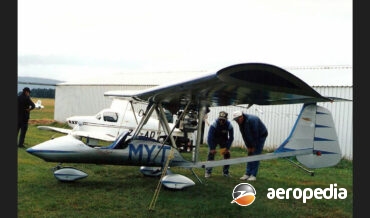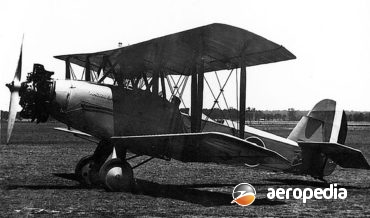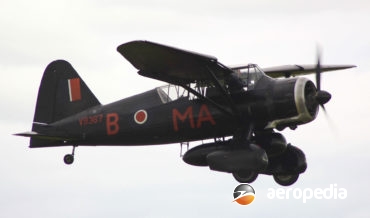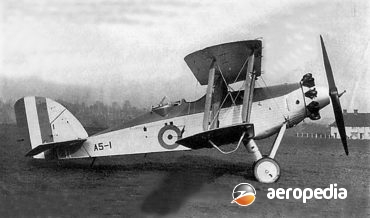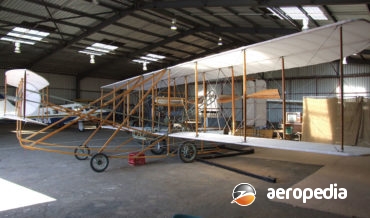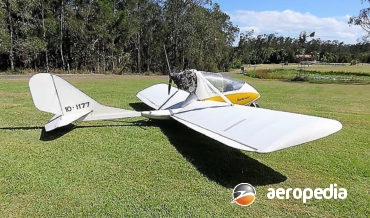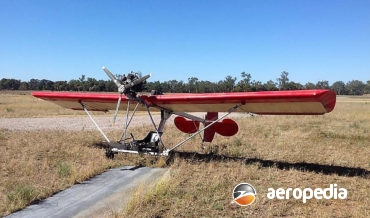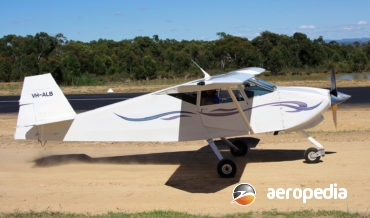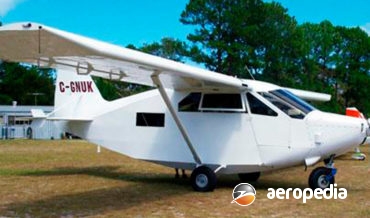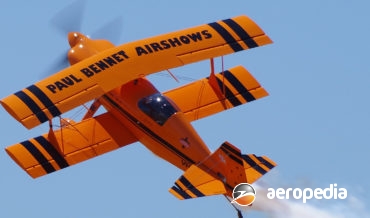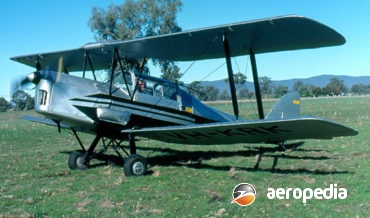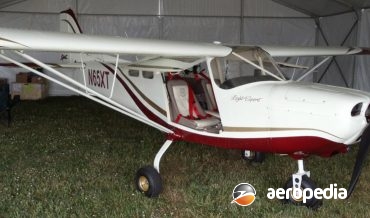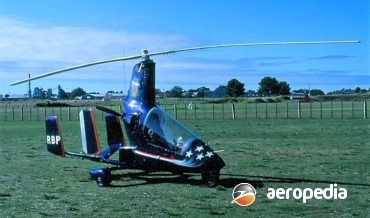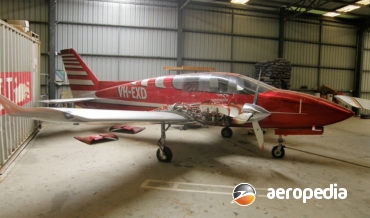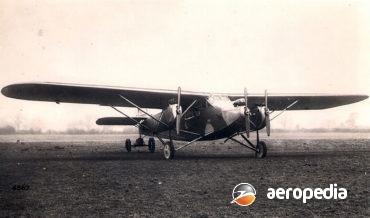All Contents
Contents
A Mr Woolfrey commenced construction of an aircraft in the Wollongong area, the aircraft being of timber construction with fabric covering. It is not thought to have flown.
David C. Eyre
- May 25, 2020
This aircraft was designed and built by Roger Ward in New Zealand, being known as TLAR, these letters standing for “that looks alright”.
David C. Eyre
- May 25, 2020
The Swing Wing was designed by Colin Winton to meet Regulation 95-10. It is a three-axis ultra-light aircraft seating the pilot in a single-seat and is a high-wing monoplane fitted with a Rotax 277 engine in a pusher configuration.
David C. Eyre
- May 25, 2020
This was one of a series of flying boats built in New Zealand for the New Zealand Flying School for training. The aircraft had a 52-kw (70-hp) Anzani radial air-cooled engine and its construction was financed by an American car dealer in Auckland, Reuben Dexter.
David C. Eyre
- May 25, 2020
The Solitaire is one of a number of aircraft designed by Colin Winton and produced by Winton Aircraft of Coomera, Qld for the ultra-light market, production of aircraft by the Company commencing in about 1976.
David C. Eyre
- May 25, 2020
This aircraft (ZK-MYT – c/n TY652) was designed and built by Bruce Walker of Tauranga, NZ. It is a high-wing microlight aircraft, the wing being a high-lift unit from a Tyro kitset built in Australia and has a 9.75 m (32 ft) wingspan.
David C. Eyre
- May 25, 2020
One of many ultralight aircraft designs of Colin Winton and his son Scott and this was the second in a line of aircraft aimed at the market and followed the Grasshopper.
David C. Eyre
- May 25, 2020
This was another of a whole range of ultralight designs produced by Colin Winton of Coomera, Qld for the ultra-light aircraft market.
David C. Eyre
- May 25, 2020
Department records indicate that in the 1920s a Mr James Winstone of Collingwood, Vic, built an aircraft and sought information about having it registered.
David C. Eyre
- May 25, 2020
The Windlass Trike, a powered hang-glider with a tricycle undercarriage, and a fibreglass fuselage to take one or two persons, has been built in some numbers around the world in a variety of models.
David C. Eyre
- May 25, 2020
This gyrocopter (registered G-395) was a freelance design fitted with a Subaru EJ-25 four-cylinder engine of 119-kw (160-hp) and fitted with 8.53 m (28-ft) diameter Patroni Glasrotor blades and a 1.93 m (76-inch) Ivo propeller.
David C. Eyre
- May 25, 2020
The Wright Mite was designed and built by Mr Dudley Wright and his brother in Queensland between 1931 and 1936. It made its first flight in 1937 and was occasionally flown in the Archerfield area.
David C. Eyre
- May 25, 2020
The Jackaroo was a high-wing ultralight designed in the early 1980s for the Australian market. It had a pod fuselage, a tricycle undercarriage and a tractor mounted modified 1200-cc Volkswagen engine.
David C. Eyre
- May 25, 2020
This was a one-off light aircraft built and flown by Barry Wrenford of Bombala, NSW, the aircraft becoming VH-YUT (c/n 1) on 29 July 2011.
David C. Eyre
- May 25, 2020
This light single-engine open-cockpit monoplane commenced life as a Taylor Monoplane. It was completed by Mr Bernard Webb and was registered for the first time on 26 August 1997.
David C. Eyre
- May 25, 2020
In 1910 Herbert Woodward of Waterloo, NSW, with his son Percival, built an aircraft similar in appearance to a Bleriot but with features similar to those found on the French aircraft types such as the Antoinette and the Pellier.
David C. Eyre
- May 25, 2020
In the 1930s Clyde Henry Weate, a taxi driver in Walgett, NSW commenced the construction of a single-seat light aircraft of his own design, this taking place in the Namoi motor garage in Fox Street.
David C. Eyre
- May 25, 2020
The White Der Jager is a single-seat light amateur-built biplane designed and market by White Aircraft, being designed by Marshall White, and is a development of the Stolp SA-500 Starlet, the intention being to make the aircraft similar in appearance to a World War I biplane.
David C. Eyre
- March 23, 2020
The Warrigal II (Warrigal being aboriginal for untamed) was a development of the Warrigal I, and was also built at Randwick.
David C. Eyre
- May 19, 2019
In 1934 under the direction of W E W Petter, to meet specifications 39/34, a design team at Westland produced the Lysander, the prototype of which (K6127) was flown on 15 June 1936 with a 627 kw (840-hp) Bristol Mercury IX engine in the hands of Harrold Penrose.
David C. Eyre
- May 19, 2019
Production of the Scout/Wasp series of light helicopters was commenced in 1957 as a private venture by the Saunders-Roe Company.
David C. Eyre
- May 19, 2019
In 1927 specification 26/27 was issued for a general purpose military aeroplane to be used for light bombing sorties, artillery observation patrols, reconnaissance and photographic work for the RAF and later target towing, and to meet this requirement the Wapiti was designed and built by the Westland Aircraft Works.
David C. Eyre
- May 19, 2019
The Westland Wessex was a British development of the Sikorsky S-58, with a turboshaft engine replacing the original piston-engine radial.
David C. Eyre
- May 19, 2019
In the late 1920s L J Wackett (later Sir) decided to design two aircraft for the RAAF, one to have a 149 kw (200-hp) radial engine, and the other to be a two-seat fighter with a 328 kw (440-hp) engine, to be known as the Warrigal I and Warrigal II.
David C. Eyre
- May 19, 2019
On 17 December 1903 the Wright brothers, Wilbur and Orville, achieved the first successful, powered, sustained and more-or-less controlled flights in a heavier than air machine in the midst of a gusty, wintry, gale on the Kitty Hawk promontory in North Carolina between the Albermarle Sound and the Atlantic Ocean.
David C. Eyre
- May 8, 2019
The Grasshopper was designed and built by Colin Winton of Winton Aircraft of Manly Vale, NSW in the 1970s and he and his Company produced 30 examples.
David C. Eyre
- May 8, 2019
The Sportsman was designed and developed by Colin Winton of Winton Aircraft of Coomera, QLD as a cheap, good handling light single-seat sporting aircraft powered by one of the popular at the time Volkswagen engine conversions.
David C. Eyre
- May 8, 2019
In 1987 Australian light aircraft Pilot, designer and builder, Scott Winton, announced he would built an all-composite light aircraft which was essentially a flying wing with a span of 6.7 m (22 ft) and a weight of 99.7 kg (220 lb), a wing area of 10 m² (107.6 sq ft)
David C. Eyre
- May 8, 2019
The Jackaroo was one of many designs produced by the late Colin Winton and produced by Winton Aircraft in Queensland and is a single-seat high-wing open-cockpit aircraft, being first made available to pilots in about 1980.
David C. Eyre
- May 8, 2019
The Jillaroo was one of a series of ultra-light aircraft designed by the late Colin Winton, others including the Brumby, Jackaroo, Sportsman and Grasshopper and they had a variety of engines including examples from the Rotax series, Hirth, Zenoah and Fuji Robin.
David C. Eyre
- May 8, 2019
In 1916 Mr C W Wittber built a biplane which was similar in appearance to a Farman, known as the Wittber Biplane or Wittber Boxkite. The engine fitted, a three-cylinder Anzani, had previously been fitted to a Bleriot XI imported by Mr F J Jones of Adelaide.
David C. Eyre
- May 8, 2019
Steve Wittman, a well-known American racing pilot since the 1920s, designed a number of racing aircraft and, due to the popularity of his designs, several designs were made available for amateur construction.
David C. Eyre
- May 8, 2019
The Wilson Explorer II, also known as the Private Explorer II, was designed by Dean Wilson and was a development of the twin-engine Global Explorer which was designed and built for French explorer Hubert de Chevigny.
David C. Eyre
- May 8, 2019
The Wolfpitts PRO is a highly refined variant of the Pitts S1S series of single-seat high-performance aerobatic biplane.
David C. Eyre
- May 8, 2019
The Jackaroo was developed by the Wiltshire School of Flying Limited at Thruxton Aerodrome, Andover, Hants in the United Kingdom in the early 1960s.
David C. Eyre
- May 8, 2019
The spirit was designed by Mr.Max Tedesco and is built by a joint American and Colombian company, the World Aircraft Company, for the light sport aircraft market and was shown for the first time to the public at AirVenture at Oshkosh in 2011.
David C. Eyre
- May 8, 2019
The Windryder is a single-seat autogyro produced by Windryder Engineering Inc of Broomfield, Colorado and the first of two prototypes, known as the Hurricane, flew for the first time in August 1985.
David C. Eyre
- May 8, 2019
The Wren 460 was a short take-off and landing conversion of the Cessna 182 using an ultra-low–speed control system devised by James L Robertson.
David C. Eyre
- May 8, 2019
The Derringer was designed by George Wing and built by his company, Wing Aircraft and Hi Shear in the early 1960s at Torrance, California as a two-seat, twin-engine sporting and training monoplane with a retractable undercarriage.
David C. Eyre
- May 8, 2019
The Westland IV was designed and built by the Westland Aircraft Works at its Yeovil facility in Somerset in 1928, being an attractive small, high wing, taxi or feeder line aircraft constructed of wood, with fabric covering and fitted with tail parts from a Westland Wapiti.
David C. Eyre
- May 8, 2019
Recent Comments
Archives
Categories
- No categories
Categories
- No categories
Latest Posts
Newsletter




